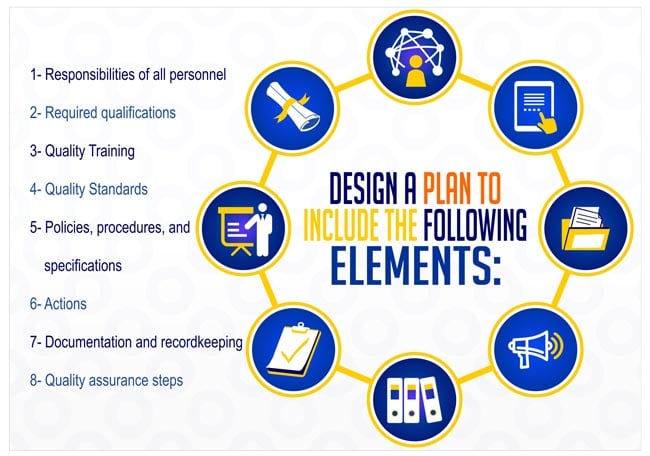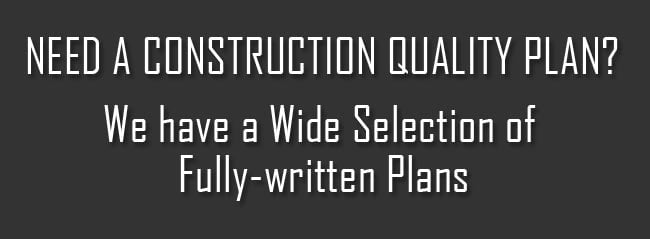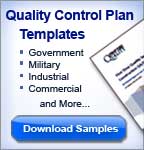
The first job of the quality management team is to design a construction quality plan for your project. Your plan has two goals. First, it should explain the company’s QA/QC policies. Second, it should identify any requirements that are unique to the project and the procedures for making both the general and the specific policies work.
While exactly what is in the quality plan will vary from project to project, there are some common elements.
1. Responsibilities of all personnel with regard to quality.
In general, everyone involved in the project should be familiar with (and/or receive training in) and be responsible within their work areas for:
- The company’s quality standards, as well as all applicable laws, regulations, codes, and material specifications
- What the project contract requires and what the customer wants and asks for
- Communicating any problems promptly so that they can be fixed quickly
The project quality plan also must include the specific duties of everyone involved in the project. Those of the quality management team themselves have been outlined earlier, but the plan should go into them in detail as they apply to that project in particular.
The quality team must prepare, and put into the job, descriptions of everyone involved in the project in terms of upholding quality standards, both general and project-specific. The team should also prepare training plans for all personnel in these standards. General company standards should be part of training before the contract is signed, but in addition some training in the specific requirements and expectations of the project is always a good idea and usually needs to be done.
2. Required qualifications of all personnel, contractors, and suppliers.
Along with the company’s general requirements for qualifications of personnel, contractors, and suppliers, which should be part of company policy and already in effect before the contract is signed, the project may have specific requirements in terms of experience, expertise, track record, and grade of materials to be supplied that aren’t required on other projects necessarily.
You need to include these in the project quality plan and strictly enforce them. This means, of course, that a new quality plan needs to be prepared for each project. Once these requirements are decided and put into the quality plan, the Quality Manager’s job is to make sure that all personnel, subcontractors, and suppliers meet these requirements. This includes any required certifications or licenses, hours of experience, and an evaluation of the quality of work demonstrated in the past.
These same standards need to apply to all third parties involved in the project, too, including subcontractors, third-party testing and inspection agents, and others.
3. Quality Training
Quality training should be offered constantly (and required periodically) for all personnel. Also, you need to train all personnel who will participate in the project in the specific demands of the project, and make instructions for this training part of the quality plan. You should have training sessions before work on the project starts and from time to time during the course of the project – especially for contractors and new personnel. Training now, saves time fixing mistakes later.
4. Project-specific quality standards
The company’s quality plan should include compliance with all applicable laws, codes, regulations, and materials standards that change depending on project location. In addition, it should include the company’s own goals and objectives with regard to quality achieved on projects it undertakes.
The quality plan for the project should include these, and add quality concerns specific to the project, as they may be more exacting than the general requirements. You’ll want to clearly state these standards up front in the quality plan. All other parts of the plan should comply with them. Note that additional training of personnel may be required for the use of new products or technical requirements.
5. Policies, procedures, and specifications to use in quality inspections and tests
As work proceeds, the main way quality is achieved is through frequent and regular inspections and tests to make sure that quality goals are being met by each step of the project. You should clearly describe when to conduct inspections and tests, what standards and criteria to use in each inspection and test, how they are to be conducted, what constitutes “passing” a test or inspection, and what constitutes nonconformance requiring correction.
6. Actions to take if defects are found
From time to time, an inspection or test report may show that work or materials on the project have failed to meet expected standards. When corrections need to be made that are not part of the normal construction process, the quality plan should spell out what to do when that happens. The options are:
- Replace: remove the work that isn’t up to standards and replace it with new construction that meets the requirements.
- Repair: correct the problem with the nonconforming work so that it meets the requirements.
- Accept: accept the nonconforming work either as-is or with partial correction.
Acceptance of nonconforming work accepted by the company must have customer approval in writing.
In addition to correcting any errors on the project itself, the Quality Manager’s job is to help the company learn from its mistakes. How can you prevent problems of this kind from arising in the future? When nonconformances occur, the Quality Manager should take actions to:
- Discover the reason or reasons why the problem occurred, and
- Correct company procedures to prevent the same thing from happening in the future.
7. Documentation and Record Keeping
You need to keep records of every step of the project. This is both to supply information for future consideration (to improve the company’s quality of work) and to provide evidence that you are following your quality plan and demonstrate due diligence in the event of a lawsuit.
The quality plan should specify exactly what reports and other documentation to prepare; whose job it is to provide them; and what information should be included. It should also specify the format and storage of the documentation for future reference.
8. End of Project Inspection and Post Project Evaluation
The last subject to deal with in the quality plan is what happens at the end of the project: the procedures for final inspections of work and final corrections of any nonconforming work. Standards for correction of problems should be the same as for corrections made during the course of the project, except that this is your last chance to get it right before the customer finds out the hard way, so it’s especially important.
Finally, you will want to conduct an overall post-mortem on your quality procedures and how they worked out for the project. Did something go wrong? That’s unfortunate, but it’s also a learning opportunity. By identifying why and how things went wrong, you can change your procedures accordingly to make sure it doesn’t happen again.
Quality is a learning process and a never-ending process of improvement. The quality plan for each project should reflect this understanding.








